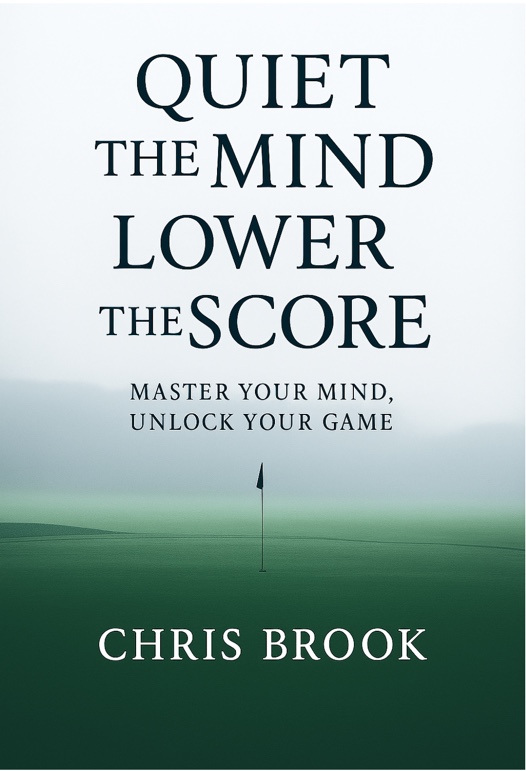Why This Matters at 75–95 mph
At 75–95 mph, you don’t have distance to waste. The fastest route to more carry isn’t “swing harder,” it’s deliver the club in a way the ball loves: slightly upward strike, efficient launch, and spin that resists ballooning but keeps the ball in the air. The difficulty? Mechanics alone rarely hold when pressure rises. That’s why this guide unites biomechanics × psychology × identity — my Three Pillars — so your delivery is repeatable when it matters.
The Three Pillars at Driver Impact
1) Technique (Biomechanics)
Set the geometry for upward strike, then move through it with efficient sequencing: ground → pelvis → thorax → arms/wrists → face delivery. The focus is impact conditions, not positions for their own sake.
- Ball high & forward; handle neutral; torso tilt right (trail-side lower).
- Pelvis rotates & “brakes” late enough to free the thorax tilt and shallow delivery.
- Trail wrist extension preserved through P6-P7; face stable, not flipped.
2) Psychology (State + Attention)
Upward AoA vanishes when threat perception spikes (tight forearms, early extension, “save it” flips). We pair each mechanical edit with one state cue so the nervous system accepts the new pattern at speed.
- Breath cadence at address → reduces tone, steadies tempo.
- Peripheral gaze → softens forearms; prevents handle drag.
- Single intention (“through the window”) → prevents over-control.
3) Performance Identity
Identity answers: “Who am I when the fairway tightens?” The story must be: I am the golfer who delivers a calm, upward strike. We encode that through language, journaling, and consequence drills.
Foundations: Setup That Prefers +5° Up
We’ll build a default setup that “wants” an upward strike without you forcing it mid-swing.
Ball, Tee, Stance, and Handle
- Ball position: just inside lead heel (or ~2 ball widths off lead armpit). Too far forward = low-heel strikes; too central = downward AoA.
- Tee height: equator of the ball ~level with or slightly above crown. At 75–95 mph, bias a hair higher to encourage high-face contact (lower spin loft for given launch).
- Stance: width ~outside of shoulders; trail foot subtly flared (10–15°) to aid pressure shift and pelvic rotation.
- Handle: near zipper; not pressed forward. Forward hands add shaft lean → more downwards strike and low-heel contact.
Tilts and Pressure
- Torso tilt: trail shoulder 1–2 inches lower than lead; trail hip subtly lower. This pre-loads side bend for upward delivery.
- Pressure: 55–60% trail foot at address, then smooth to ~70% trail by the top. No hard “sway”— keep head quiet.
Kinematics: How +5° Up Emerges
+5° isn’t “add lift at impact.” It’s the result of earlier relationships:
- Ground + pelvis: moderate trail-side pressure in backswing; transition uses trail-to-lead shift and rotational braking late enough to maintain thorax tilt.
- Thorax: from transition, maintain trail-side tilt as rotation increases; this shallows delivery and promotes upward strike.
- Arms/wrists: trail wrist extension sustained into P6-P7; lead wrist near flat. Handle forward = down AoA; handle neutral with tilt = up AoA.
- Face delivery: stable through impact (no rescue flip). Intention is through a “strike window,” not at the ball.
Opposite Pairs (so you don’t over-correct)
- More tilt requires committed rotation (tilt without turn → blocks/hooks).
- Upward AoA with high-face needs sufficient speed/loft to avoid floaters.
- Soft arms need a strong pivot (soft without pivot = timing games).
Tailoring: 10-Handicap Women vs Men (75–95 mph)
| Area | 10-hcp Lady (75–85 mph) | 10-hcp Male (85–95 mph) |
|---|---|---|
| Loft | 11–13.5° (consider 12° head) | 9.5–11.5° (often 10.5°) |
| Tee Height | Mid-high (prioritise high-face) | Mid (avoid too low heel strikes) |
| Face-to-Path | Small draw bias (+0.5 to +1.5) | Neutral to tiny draw |
| Spin Target | 2400–2700 rpm | 2200–2600 rpm |
| Tempo | Smooth; complete backswing | Steady; avoid rush from the top |
| Key Cue | “Tilt then turn through window” | “Turn with soft forearms” |
Drills That Build the Pattern
1) The “Two Coins” Strike Window
Place two coins: one 2 inches ahead of the ball on target line, one 1 inch above (imagine a small vertical window). Intention: swing “through the window,” not “at the ball.”
- Biomech effect: promotes forward, upward exit with stable handle.
- Psych effect: attention external; reduces rescue flips.
2) “Wall of Tilt” with Club Across Chest
Club across chest, rehearsal swings holding trail-side low as you turn. Feel pelvis rotate then “brake,” thorax keeps tilt, arms swing past body.
3) Tee-Line Ladder (Consequence)
Set 5 tees along target line (every 2 yards). Must start the ball through the second or third tee gap 4/5 attempts before moving back one gap. Miss? Restart the set.
4) High-Face Contact Finder
Use face tape/foot powder. Goal: strike slightly above centre. If low-heel, raise tee or check handle lean.
5) Breath-Lock Rehearsal (Psych Coupling)
- At address: inhale 3s → exhale 4s (jaw/forearms relax).
- On takeaway: continue gentle nasal airflow (prevents freeze).
- At finish: one sigh through mouth (release evaluation).
Common Mistakes (and Quick Fixes)
- Downward AoA despite forward ball: handle too far forward → neutralise handle, re-establish torso tilt.
- High, floaty launches: too much spin loft (low-face contact or adding loft with flip) → raise tee, keep trail wrist extended into impact.
- Blocks/hooks when adding tilt: kept tilt but stopped turning → feel ribcage turn left through impact while trail side stays low.
- Rushing from top: add exhale before transition; hear the breath finish as the downswing starts.
Equipment Notes (Simple & Practical)
- Loft first: aim to launch 11–13° with your natural contact. At 75–85 mph, do not fear 12°.
- Shaft profile: choose what helps centre-face contact and tempo. If tip-stiff causes low-heel, consider mid tip.
- Face angle/hosel: small draw bias can assist +5° AoA players who fight open face.
On-Course Transfer: The Process That Holds
Range brilliance means nothing if it dies on the first tee. Use this on-course micro-process:
- Picture: a flight window ~10 yards wide, apex point chosen.
- Breath: one slow exhale, jaw soft.
- Cue: “Tilt & turn through the window.” (not technical words; it’s a feel/aim cue)
- Swing: finish tall; hold pose for one heartbeat.
- Reset: if miss: exhale, neutral phrase “Ball gone, job now,” re-address the next shot.
Identity: Who You Are with the Driver
Pick one identity sentence and write it inside your headcover:
- “I am the golfer who delivers a calm, upward strike.”
- “I reset faster than anyone on this tee.”
- “My window is clear, my body turns, my face stays quiet.”
Identity is trained like any motor pattern: short, frequent reps. Read it at the range. Whisper it on the tee. Journal it after rounds.
A Simple 2-Week Builder (75–95 mph)
| Day | Focus | Measure |
|---|---|---|
| Mon | Setup & tilt rehearsals (no ball), 30 swings | Video: trail shoulder lower at address |
| Tue | High-face finder, 40 balls | ≥70% above-centre strikes |
| Wed | Tee-line ladder (consequence) | Complete 2 ladders |
| Thu | Pressure: 10 balls, 1 ball each station | Breath tick on every shot |
| Fri | On-course 9 holes (driver holes only) | Mental scorecard ticks ≥28/36 |
| Sat | Rest or short feel set | Journal 3 behaviours |
| Sun | Play 9–18; identity cue | 1 sentence repeated on each tee |
Troubleshooting by Ball Flight
- Low-left rope (hook): added tilt but under-rotated → feel chest exiting left while trail side stays low; soften right forearm.
- High-right hold (block/fade): handle too forward or face open → keep trail wrist extended but allow chest to cover through; check grip not too weak.
- Ballooning high: low-face + added loft → raise tee; aim for slightly high-centre strike.
- Smother top: head lurching forward → rehearse slow exhale at set and stillness through takeaway.
Quiet the Mind × Biomechanics: How We Link Them
In Quiet the Mind, Lower the Score I teach that feelings follow actions. At driver, the action is a calm, upward, rotational strike. We therefore pair every mechanical edit with a state behaviour:
- Mechanical: neutral handle, torso tilt → State: exhale + soft jaw.
- Mechanical: trail wrist extension → State: peripheral gaze (reduces forearm tone).
- Mechanical: turn through window → State: one intention only.
Driver FAQ (75–95 mph)
Is +5° up AoA always best?
No—±1° either side can be optimal based on loft, face contact, and curvature. The window (4–6° up) is the target; chase pattern quality first.
Should I chase draw bias?
Only if it supports centred, high-face contact and simple start lines. A tiny draw often helps launch/spin at these speeds, but neutrality that’s repeatable beats forced curvature.
How fast can I expect change?
Setup and contact can improve immediately; stable on-course delivery typically takes 2–6 weeks using the breath + picture + reset process.
What if pressure ruins me?
It’s not you; it’s your process. Add consequence ladders, keep one intention, and score your behaviours every hole. Confidence returns when evidence accumulates.
Bottom Line
At 75–95 mph, energy is precious. Stop leaking it with downward strikes and rescue flips. Build a setup that prefers +5°, rehearse tilts that survive rotation, and glue the pattern with breath, gaze, and a single intention. Track behaviours, not just strokes. Your carry will rise, dispersion will narrow, and — most importantly — your driver will hold up when the fairway tightens.

